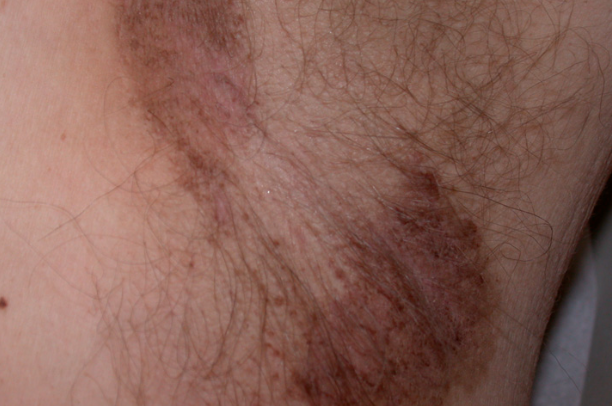Granular parakeratosis (axillary or intertriginous granular parakeratosis) is a benign condition characterized by scaly patches, hyperkeratotic papules, and plaques in skin folds. ICD-10 code is R23.4.
The disease can occur in individuals of all ages and both sexes, but is more common in women between the ages of 40 and 60, with a ratio of 25:1 compared to men. There have been reported cases of the condition in children of early childhood. In general, the disease is more common in individuals with skin types III-VI.
The etiology and pathogenesis are not fully understood. It is believed that a defect in the metabolism of filaggrin during its conversion from profilaggrin plays a major role in the development of the disease. Some suggest that granular parakeratosis is the result of a protective mechanism in body folds with a moist environment subjected to mechanical irritation.
Predisposing factors in adults include:
- Use of antiperspirants and deodorants
- Hyperhidrosis (excessive sweating)
- Presence of occlusive and moist environments
- Excessive use of creams
- Mechanical irritation
- Obesity
In children, predisposing factors include:
- Use of diapers
- Frequent and excessive washing
- Overuse of powders containing zinc oxide
There have been isolated reports of an association between the condition and dermatomyositis, molluscum contagiosum, and malignant tumors.
The disease is characterized by the appearance of pruritic, scaly, erythematous, hyperpigmented macules and hyperkeratotic papules of yellow, red, reddish-brown, and sometimes dark brown color that may coalesce to form well-defined plaques with irregular borders. These lesions are often round or linear in shape and have a reticular configuration. In rare cases, erosions and fissures may form on the surface of the plaques.
The rash is most commonly localized in the axillary region, but may also be found in the submammary folds, abdomen, back, perianal region, and neck. The eruptions may be symmetric or unilateral. The disease is chronic in nature and in most cases resolves spontaneously within a few months; however, recurrences are common. Patients associate exacerbations of the disease with increased temperature, humidity, and profuse sweating.
Pediatric form: In the pediatric form of the disease, lesions in the form of symmetric erythematous or hyperpigmented plaques are localized in the perianal and inguinal folds.
- Acanthosis Nigricans
- Pemphigus Vegetans
- Chronic Irritant Dermatitis
- Lichen Planus Pigmentosus
- Tinea Corporis
- Granuloma Annulare
- Intertrigo
- Seborrheic Dermatitis
- Inverse Psoriasis
- Erythrasma
- Darier Disease
- Hailey-Hailey Disease
- Dowling-Degos Disease
- Terra Firma Forme Dermatosis
There is no optimal therapy for this condition. Patients are advised to avoid the use of deodorants and creams.
Topical treatment includes creams and ointments containing corticosteroids, antibiotics, calcipotriol, tretinoin, and antifungals. The use of ammonium lactate lotion is recommended.
Systemic therapy may include antibiotics, antifungals, and isotretinoin.
Other treatment options include cryotherapy, botulinum toxin injections, and laser therapy.

